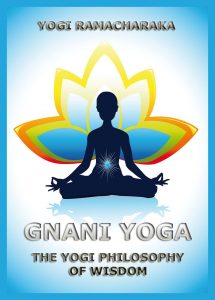Gnani Yoga – Yogi Ramacharaka
“Gnani Yoga” is the “Yoga” of Wisdom. It is followed by those of a scientific, intellectual type, who are desirous of reasoning out, proving, experimenting, and classifying the occult knowledge. It is the path of the scholar. Its follower is strongly attracted toward metaphysics. Examples of the idea of “Gnani Yoga”—apparently widely differing examples—are to be seen in the great philosophers of ancient and modern times, and in the other extreme, those who have a strong tendency toward metaphysical teachings. As a matter of fact, nearly all students of the Yogi Philosophy, are more or less attracted to “Gnani Yoga”, even though they be said to be following one of the other of the three paths. This book consists of twelve lessons that explain the basics, principles and secrets of Gnani Yoga.
Format: Paperback.
Gnani Yoga.
ISBN: 9783849685676
Available at amazon.com and other venues.
What is Gnani Yoga? (from Wikipedia):
Gani, or Jnana, is knowledge, and refers to any cognitive event that is correct and true over time. It particularly refers to knowledge inseparable from the total experience of its object, especially about reality (non-theistic schools) or supreme being (theistic schools). In Hinduism, it is knowledge which gives Moksha, or spiritual release while alive (jivanmukti) or after death (videhamukti). According to Bimal Matilal, jnana yoga in Advaita Vedanta connotes both primary and secondary sense of its meaning, that is “self-consciousness, awareness” in the absolute sense and relative “intellectual understanding” respectively.
According to Jones and Ryan, jnana in jnana yoga context is better understood as “realization or gnosis”, referring to a “path of study” wherein one knows the unity between self and ultimate reality called Brahman in Hinduism. This explanation is found in the ancient Upanishads and the Bhagavad Gita.
Jñāna yoga is the path towards attaining jnana. It is one of the three classical types of yoga mentioned in Hindu philosophies, the other two being karma yoga and bhakti. In modern classifications, classical yoga, being called Raja yoga, is mentioned as a fourth one, an extension introduced by Vivekananda. Jnana yoga, states Stephen Phillips, is the “yoga of meditation”.
Of the three different paths to liberation, jnana marga and karma marga are the more ancient, traceable to Vedic era literature. All three paths are available to any Hindu, chosen based on inclination, aptitude and personal preference, and typically elements of all three to varying degrees are practiced by many Hindus.
The classical yoga emphasizes the practice of dhyana (meditation), and this is a part of all three classical paths in Hinduism, including jñāna yoga. The path of knowledge is intended for those who prefer philosophical reflection and it requires study and meditation.
(The text of the last section was taken from a Wikipedia entry and is available under the the Creative Commons Attribution-ShareAlike License.)
Publisher’s Note: This book is printed and distributed by Createspace a DBA of On-Demand Publishing LLC and is typically not available anywhere else than in stores owned and operated by Amazon or Createspace.

